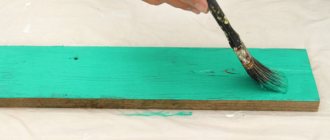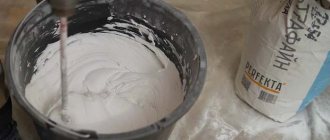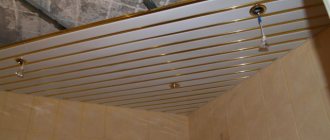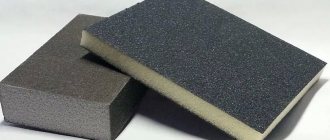Due to mechanical loads, the surface of the bathtub may lose its original attractive appearance. Flaws in the enamel not only spoil the appearance, but also lead to other problems with the product. One solution to the problem is to replace the bathtub, but due to the cost of the issue it is not always available. Therefore, you can restore the enamel in the bathroom yourself. This will be discussed in detail below.
Why is it necessary to renew enamel?
Restoring the bathtub enamel is required not only for its attractiveness; the presence of chips and rust will ultimately lead to the complete destruction of the plumbing fixtures. Enamel is a protective layer from high temperatures, cleaning agents, and sudden changes in temperature. If you do not take care of repairing the coating, the product will not last long.
It is possible to enamel the surface of the bathtub yourself; this option is inexpensive. Therefore, it will be possible to save money, which will not happen when buying a new one.
Restoring the bathtub enamel is required not only for its attractiveness; the presence of chips and rust will ultimately lead to the complete destruction of the plumbing fixtures.
Preliminary work
Preparatory work begins with pouring cleaning powder into the bathtub, which is carefully rubbed over its surface with sandpaper. First of all, attention should be paid to chipped voids, webs of cracks and oxidation products. If the rust cannot be removed due to deep penetration, you can use oxalic acid. It is diluted with water to a porridge state and the areas with rust are wiped with a cloth swab. After half an hour, the bath is thoroughly washed.
The bath should not be left for more than 30 minutes, as the acid can damage the enamel.
Cleaned and dried cast iron bath enamel should be degreased. To do this, moisten a swab with gasoline or acetone and wipe the bath with it. Then the pre-filled bath is left in hot water for 15 minutes. After draining the liquid, the walls and bottom of the sanitary ware are dried.
Drying is considered completed after not only the bottom and walls of the bathtub, but also the enamel pores are freed from moisture. Therefore, it is better to dry the entire bathroom area with a fan or a specially created draft.
After completing the preliminary work, you can begin restoring the enamel.
Properties of cast iron as a bathroom material
Cast iron bathtubs are in demand due to their durability. In production, the casting technique is used. The following advantages of cast iron plumbing can be highlighted:
- Wear resistance, the material can last up to fifty years, the enamel layer is not so durable, but with its timely restoration, the shelf life of the beautiful coating can be extended several times;
- They transmit less noise than other materials, this is due to the thickness of cast iron, which reaches up to 8 mm;
- The enameled surface can be repaired independently; the material lends itself well to restoration work;
- The base cools down slowly, so you can soak in a warm bath longer.
Cast iron bathtubs are in demand due to their durability.
Acrylic bathtub liner
Instead of working on the old coating, a new plastic trough is simply inserted into the bathtub, repeating its shape. It is attached to a special foam and looks like a new bathtub. However, there are many “buts” here:
Firstly, this method is not suitable for steel bathtubs and bathtubs made of thin cast iron, because they bend. Although this movement may be invisible to the eye, it will greatly reduce the life of the liner: it comes off or microcracks form into which water gets in, stagnates there and begins to smell unpleasant.
Secondly, if you have an old Soviet bathtub, it is most likely uneven and irregular in size, so the liner may simply not fit. Or there will be the same problem as in the paragraph above.
Third, another element comes into play here: the adhesive foam that holds the liner inside. If its quality is low or there are other unfavorable factors, the bathtub will simply fall apart.
The liner is glued and adjusted for about 2 hours, and then the bath is filled with water for a day. After a day you can use it. Acrylic should not be rubbed with abrasives. It is better not to turn on sharply hot water, but to let the bath gradually warm up.
Pros:
- no smell during restoration;
- ideal restoration of cracks, chips and any other visual imperfections - it’s literally a new bathtub;
- impact-resistant and warm to the touch material;
- does not turn yellow over time.
Minuses:
- unreliable design;
- the specified service life of about 15 years is rarely realistic;
- high price;
- the need for additional payments for dismantling/installation of the siphon;
- if the bathtub is built into tiles, removal of the tiles is necessary;
- a thickness of 7-8 mm “eats” the volume of the bath.
Which is better: restoration or replacement?
When deciding whether to restore the enamel in the bathroom or better replace it, you need to take into account the advantages of the second option. Purchasing a new product is simple, but to install a new bathroom you will have to remove and remove the old one, the process is not so easy.
Problems that you may encounter when replacing plumbing fixtures:
- Removing an old item may result in defects in the finish;
- Sometimes it may be necessary to widen the doorway;
- To remove the bathroom, some people have to hire movers and a car, which adds up to huge expenses.
These issues will not arise when deciding to restore the enamel; you can do the work yourself or turn to professionals for help.
Purchasing a new product is simple, but to install a new bathroom you will have to remove and remove the old one, the process is not so easy.
How to restore a bathtub
A new bathtub is not a cheap pleasure.
The cost of acrylic models starts from five thousand rubles, cast iron - from eight, and the upper price bar goes to infinity. Don't forget to add replacement costs: dismantling the old bathtub; paying movers to remove it from the house; delivery and installation of a new bath; repositioning side tiles. Renovating an old bathtub will cost an average of 2,000 to 5,000 rubles, depending on the size of the bathtub, type of restoration and material, so many people choose this method. During the last renovation, I myself did restoration, not replacement. My choice fell on poured acrylic, but we will consider other methods, because they all have their pros and cons.
Types of enamels for painting
Painting the base with enamels is the most popular repair option. There are two types of enamel compositions: regular and professional. The first one is more suitable for beginners, the layer turns out to be thick, so you can get by with a single layer application, but minor defects may remain.
The second one is difficult to apply due to the thin layer of paint. The paint is liquid and flowing, it is difficult to avoid stains without experience. To obtain the desired level of coloring, many layers are done; such a correct coating requires skill.
Painting the base with enamels is the most popular repair option.
What you will need
Before restoring the enamel of the bathtub, it is necessary to prepare in advance the required tools and materials:
- Protective equipment: respirator, gloves, clothing;
- Brush and roller;
- Sandpaper or sander;
- Primer solution;
- Acetone;
- Rags;
- Enamel.
On the construction market you can find aerosol compositions and standard liquid ones. There are ready-made kits and repair kits for small jobs. For complete coloring, it is advisable to use regular enamel; to seal minor defects, you can use a spray can. Applying enamel from a can over the entire surface will not have an even appearance.
Before restoring the enamel of the bathtub, it is necessary to prepare the required tools and materials in advance.
Metal bath: enamel restoration process
No matter how carefully your family handles a metal bathtub, chips and scratches will still appear over time, in which rust will accumulate. It happens that finances do not allow you to buy a new bowl, but repairing it is easy. But everything is in order. Why is it easier to repair a steel bathtub rather than buy a new one:
- Dismantling and installing the bowl takes time;
- The wall covering deteriorates;
- Money is spent on purchasing, removing the bowl and other small items.
Restoring a steel bathtub does not require such investments, especially if you use special products. For example, varnish. In terms of durability, the product is not inferior to an enamel coating, and its application is simple and easy. If you have the ability to use a paint brush or roller, then repairing an iron bathtub is almost “in your hands.”
Important! By choosing varnish instead of paint, you give preference not only to durability and quality, but also to the absence of odors and a long drying process.
This varnish is sold in specialized stores and has three components that are mixed before starting work. The quality of the coating directly depends on the preliminary preparation of the bowl. That is why very thorough cleaning of surfaces, removal of all lime deposits, grinding and simple dust removal is required.
Restoration methods, their advantages and disadvantages
At home, you can carry out the following types of restoration work on the surface of the bathtub:
- Enamel painting;
- Liquid acrylic coating;
- Gluing a special liner.
They all differ in their advantages and disadvantages; in order to understand which option will be closer, you need to study the intricacies of each.
To understand which option will be closer, you need to study the intricacies of each.
Enamel painting
The enamels used in production cannot be applied at home. The reason is the need to warm up the base. There are enamel compositions that do not require such manipulations. But they will not last long, about five years; you cannot use abrasive products for maintenance.
But it will be possible to paint the entire surface, a variety of shades, you can get any color, it will be possible to repair the layer if necessary.
A variety of shades, you can get any color.
Liquid acrylic
A composition called Stacryl is used, a technique called pouring bath. The layer will not be able to cover the unevenness, it is necessary to remove the siphon before work, skills are required from the master, the process is not easy.
The advantages are considered to be quick drying within a day, the price of the product is low, and does not emit a strong odor.
The layer will not be able to cover the unevenness, it is necessary to remove the siphon before work, skills are required from the master, the process is not easy.
Acrylic insert
In this case, a special tab is placed over the entire surface. Due to the size of the insert, the cost is quite high, and finding a suitable option for a specific bathtub is not easy. The positive aspects include speed of installation and lightness, durability; the insert can last up to 20 years. However, the price will be almost the same as when buying new plumbing fixtures. The size of the base will decrease slightly.
Due to the size of the insert, the cost is quite high, and finding a suitable option for a specific bathtub is not easy.
Bathtub restoration with acrylic
Coating a bathtub with acrylic paint is a simple process that you can do yourself. But do not forget that all painting work should be carried out in well-ventilated areas with open windows. It is best to leave the apartment unoccupied for a while so that they do not breathe harmful fumes.
Be sure to wear a respirator. An ordinary medical mask will not work; more serious protection is needed. Feel free to wear a military gas mask if you have one.
To avoid getting dirty, you need to wear rubber gloves and a rubberized apron. Have spare gloves on hand so you can change them.
This liner can only be cleaned with special products for acrylic. Under no circumstances should powdered products be used.
There are reviews that you cannot put heavy things in such a bathtub. This is not true. The acrylic liner perfectly withstands loads of 100-130 kg.
This liner must be installed correctly. If you glue it not tightly, then water will get into the space between the bathtub and the liner. Therefore, it is necessary to choose a good installation specialist.
Instructions for restoring enamel
Renovation work in the bathroom begins with the preparatory stage. The final result depends on the quality of preparation; it is also important to properly apply and dry the base.
The final result depends on the quality of preparation; it is also important to properly apply and dry the base.
Preparing for work
First, remove all possible objects from the room so that dust does not fall on them during the removal of the old finish, or cover the surface with film. Next steps:
- They start by removing the old layer; you can use sandpaper or a grinding machine. It is necessary to completely remove the paint to obtain a smooth surface.
- Corroded areas are eliminated using a converter.
- The base is treated with a degreaser.
- Hot water is drawn in, it should heat the bath for 15-20 minutes.
- The base is wiped with a rag, from which the lint does not come off.
They work in rubber gloves and a respirator.
They start by removing the old layer; you can use sandpaper or a grinding machine.
How to restore the surface with enamel
It is advisable to prime the base; this step helps to obtain the desired smoothness. Proceed as follows:
- Using a rubber spatula, spread the primer over the base; when the layer is dry, sand the base with sandpaper.
- Apply with a brush or roller 3-4 layers are necessary, a new one is applied only to a completely dry base.
- The dried surface is treated with thinner to obtain gloss.
It is advisable to prime the base; this step helps to obtain the desired smoothness.
How to update a bathtub with liquid acrylic
If liquid acrylic is selected as the coating, then the steps described below are performed:
- Remove the siphon and place a container underneath so that the paint flows there;
- An acrylic solution is being prepared;
- The process begins from the far corner part and goes further in a circle. Sagging will disappear on its own during drying;
- The remaining acrylic on the bottom can be spread with a spatula.
Drying takes up to four days.
Sagging will disappear on its own during drying.
Comparison of coatings
To figure out which is better for a bath: acrylic or enamel, let’s make a comparison. In this case, we will select as criteria:
- cost of work, because For Russians, this factor is one of the main ones, and in most cases the only one;
- lifetime. The effectiveness of investments in bathtub renovation depends on the characteristics. Unfortunately, due to limited funds, the choice is largely determined by money: what is cheaper is what is bought;
- difficulty of repair;
- resistance to external factors. Generalizing criterion. This includes resistance to high temperatures, detergents and mechanical stress;
- ease of use;
- difficulty of care;
- variety of design.
Which is cheaper?
You can restore a bathtub with acrylic composition for 3,000 rubles. and more. To buy enamel paint you need only 2200 rubles.
Conclusion: if you have limited funds, it is cheaper to restore a bathtub with enamel.
Lifetime
The acrylic coating of a cast iron bathtub can last from 10 to 15 years - it all depends on the intensity of use. Epoxy enamel lasts 2 times less: from 5 to 10 years.
Conclusion: acrylic coating will help you avoid frequent repairs.
Difficulty of repair
Experts have different opinions on the difficulty of repairs. Some people think that painting a bowl with acrylic is easier: you don’t need a brush or a roller. Others, on the contrary, consider the difficulties of restoring the surface with acrylic to include the long period of its hardening.
Same with enamel. The advent of spray-on epoxy resin cans has made the repair process simple. But many people do not like the strong smell and the need to work in protective equipment.
Conclusion: both methods of restoring a font are simple methods that can be done independently.
Resistance to external factors
Acrylic is a more “delicate” type of material than enamel: it is afraid of hot water, sharp objects and aggressive detergents containing alcohol, acid, alkali or chlorine. In this regard, enamel is more durable, although it does not reach the characteristics of the factory coating.
Conclusion: if there are children under the age of 10-12 in the family, it is better to refrain from using acrylic - there is a high risk of damage to the coating, as a result of which the repair will have to be carried out again.
Ease of use
A bathtub covered with acrylic warms up quickly, it’s pleasant to lie in, and you don’t need to frequently add hot water. Another advantage according to the criterion: the coating is not slippery.
Conclusion: according to all criteria indicators, acrylic coatings have an undoubted advantage.
Difficulty of care
The second criterion where enamel leads in comparison: difficulty of care. There is no need to buy special, expensive care products for enamel. Liquid soap and a foam sponge are enough.
Conclusion: cleaning an enamel bath is much easier and faster.
Design
A cast iron enameled bathtub can only be white. But with acrylic, the choice is unlimited in this regard. You can choose any shade, which will enliven the standard design of the room.
Conclusion: using acrylic allows the designer to use the most fantastic ideas for decorating a bathroom.
How to repair a bathtub using a liner
This option is suitable for any type of bath: steel, cast iron, etc. But the price will be high and you need to choose the right insert for the size. Then the following is done:
- The base is degreased.
- Check that the hole for the drain in the insert matches the bathroom; if necessary, cut off the area.
- Inside the plumbing, the surface and the outer zone of the insert part are covered with glue.
- The “new thing” is inserted, the butt parts are treated with silicone compound.
Cold water is drawn in, and it should press its weight onto the product for 24 hours.
This option is suitable for any type of bath: steel, cast iron, etc.
How to repair minor enamel damage yourself
If only small chips or other minor defects appear, then simpler repairs can be carried out. It is important to start recovery faster, then the spread of the flaw will stop.
If only small chips or other minor defects appear, then simpler repairs can be carried out.
Small chips
Such a flaw is covered with BF glue mixed with dry white. Several layers are applied, using the last one you need to align the area with the main part. Each layer must dry.
Such a flaw is covered with BF glue mixed with dry white.
Not very deep chips
For this problem, a solution made from nitro enamel, matched to the shade of the bathtub and “Super Cement” is suitable. The treatment is also done in multi-layers, the layers dry for 24 hours.
For this problem, a solution made from nitro enamel, matched to the shade of the bathtub and “Super Cement” is suitable.
Porous enamel
In this case, you will need nitro paint. Pour paint onto the bottom and rub it forcefully into the base. A multi-layer coating is made to cover all the cracks. Excess product is removed with a swab containing diluent. It is advisable to use spray paint as the final layer.
A multi-layer coating is made to cover all the cracks.
Brief summary
The comparative analysis carried out shows that, in principle, the question of how to cover a bathtub, acrylic or enamel, should not arise. The slightly higher cost of acrylic coating (about 800 rubles) pays off with a service life of at least 2 times longer. If the cost of repairs is broken down by year, then an acrylic coating will cost 210 rubles. per year, and enamel - more than 280 rubles.
According to other criteria, enamel loses by an overwhelming advantage. The exception is product care. However, practice has shown that there are many ways to wash acrylic using affordable, yet cheap, products, which you can read about in the article “How to wash an acrylic bathtub.”
How to care for new enamel
After restoration work, it is necessary to follow the rules of surface care for long-term operation:
- Try not to drop heavy objects inside;
- It is undesirable to pour boiled water; avoid sudden changes in temperature;
- Do not soak clothes in bleach inside;
- Do not use abrasive cleaning agents or aggressive compounds.
Do not use abrasive cleaning agents or aggressive compounds.
You can restore the integrity of the bathtub with your own hands. If you act step by step, you can get a good result. Such repairs will extend the life of the product.
Which bathroom is easier to care for?
An enamel bathtub, like an acrylic-coated one, should be kept dry between uses due to the possibility of permanent stains appearing on it. Metal sponges and coarse abrasive substances are not suitable for both materials due to the high probability of microcracks.
Just like with acrylic, a stain that appears on the enamel must be removed immediately so that it does not have time to become embedded. After using detergents, the enamel must be rinsed thoroughly, since leaving them on the surface for a long time can destroy the coating layer.
The cost of specialized products for acrylic is higher than for enamel. At the same time, you can also choose suitable ones from cheaper ones. Caring for enamel and acrylic coatings is almost the same and simple. The main thing is not to scratch the surface and keep the bath clean and dry.











